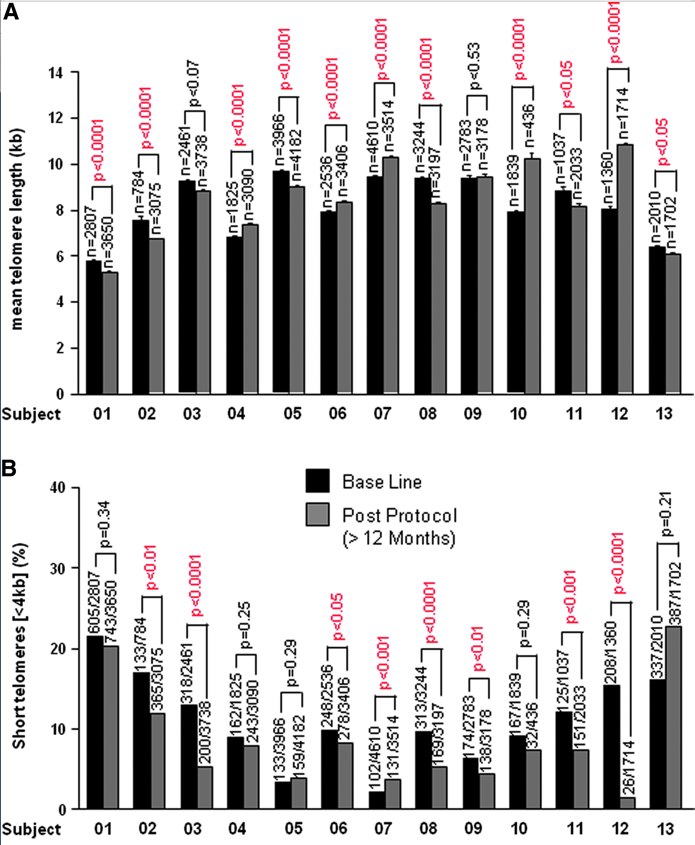1. There's no clear cut answer to that, I don't think anybody has measure telomere on the amounts you proposed to know for sure which one is more effective. In my opinion, whatever you end up doing take either Cyclo or TA65 and don't bother with AIV. Cycloastregenol is by far the most studied and proven substance.
Actually, a user on this site has done repeated telomere length measurements after sequentially using Cycloastragenol, Astragaloside IV, and Standardized Astragalus extract. Here's his post from Nov 2011 in its entirety with back links to posts of previous test results. Granted, its anecdotal, overlapped use of other supplements like Ginkgo Biloba, and didn't specifically include the branded product TA65, but it is a measured result that includes TA65's known components...
It’s time for one of my longer posts. I have now got the results from my latest FLOW-Fish test after using "Standardised Astragalus Root Extract" (mostly) for eleven months. If someone thinks this post looks a lot like the one I made in December last year, this is because I’m repeating a lot of the results from that post.
For comparison I've got data from four earlier tests.I have now made another test after 11 months on "Standardised Astragalus Root Extract"
- Baseline Test
- After 6 months on Astragaloside IV
- After 6 months on Cycloastragenol
- After 6 months on "Standardised Astragalus Root Extract"
In order to not repeat to many of my results you can look at the details of the data from these tests in post #787 and post #1077. In post #1073 you can see the details on the execution of my last test of 6 months on "Standardized Astragalus Root Extract". For all tests, I had the lab analyze the Standard Deviation. This cost more money but ought to make the numbers slightly more reliable.
SUMMARY OF COLLECTED DATA
Astragaloside IV
6 months on AIV and Gingko Biloba + 3 last months on Orlistat rendered the following changes from my baseline values:
Lymphocytes: 7.5-7.0 = reduction of 0.5 kb
Granulocytes: 9.1-7.4 = reduction of 1.7 kb
Naive T-cells: 8.3-7.9 = reduction of 0.4 kb
Memory T-cells: 6.3-5.6 = reduction of 0.7 kb
B cells: 8.2-8.1 = reduction of 0.1 kb
NK cells: 4.5-4.0 = reduction of 0.5 kb
When using Astragaloside IV the Standard Deviations changed from
Lymphocytes: 0.6 to 0
Granulocytes: 1.2 to 0
Naive T-cells: 0.4 to 0
Memory T-cells: 0.7 to 0
B cells: 0.7 to 0
NK cells: 0.7 to 0
Cycloastragenol
6 months on Cycloastragenol (including Chitosan) and Gingko Biloba and Orlistat rendered the following changes from the last period.
Lymphocytes: 7.0-7.0 = No change
Granulocytes: 7.4-7.3 = reduction of 0.1 kb
Naive T-cells: 7.9-7.9 = No change
Memory T-cells: 5.6-5.7 = Increase of 0.1 kb
B cells: 8.1-8.2 = Increase 0.1 kb
NK cells: 4.0-4.1 = Increase of 0.1 kb
When using Cycloastragenol the Standard Deviations changed from
Lymphocytes: 0 to 0.2
Granulocytes: Still 0
Naive T-cells: 0 to 0.3
Memory T-cells: 0 to 0.2
B cells: 0 to 0.2
NK cells: 0 to 0.3
"Standardised Astragalus Root Extract", 6 months
6 months on Standardised Astragalus Root Powdered Extract (1mg [0.5%] triterpene glycolides) 225mg, Raw Astragalus Root Powder 250mg, Gingko Biloba, Orlistat (phasing out), "Adidas miCoach Get Fit Stay Fit - Level 4" (3-4 months) and Meditation (3-4 months) rendered the following changes from the last period.
Lymphocytes: 7.0-6.9 = reduction of 0.1 kb
Granulocytes: 7.3-7.6 =Increase of 0.3 kb
Naive T-cells: 7.9-8.1 = Increase of 0.2 kb
Memory T-cells: 5.7-5.8 = Increase of 0.1 kb
B cells: 8.2-8.2 = No change
NK cells: 4.1-5.9 = Increase of 1.8 kb
When using "Standardised Astragalus Root Extract" the Standard Deviations changed from…
Lymphocytes: 0.2 to 0.0
Granulocytes: 0 to 0.1
Naive T-cells: 0 .3 to 0.0
Memory T-cells: 0.2 to 0.0
B cells: 0.2 to 0.0
NK cells: 0.3 to 0.2
"Standardised Astragalus Root Extract", 11 months
During 11 months I have been taken the following supplements and done the following activities.This rendered the following changes from the last period.
- 1 month, trying to take Cycloastragenol 10mg/day but having to give it up (see earlier posts).
- 10 months on Standardised Astragalus Root Powdered Extract (1mg [0.5%] triterpene glycolides) 225mg, Raw Astragalus Root Powder 250mg, taking one pill in the morning and one during late afternoon,
- 11 months on Gingko Biloba, 1 pill around lunchtime
- Orlistat, on and off during the period,
- "Adidas miCoach Get Fit Stay Fit - Level 5, 30 minutes", using cross trainer for 20 minutes and a rowing machine for 10 minutes, two times per week,
- Meditation during working days, unfortunately circumstances did not make it possible to meditate more than about three days per week (60% of target),
- During the last five months, been using Minoxidil (50mg/ml) for extended periods,
- Had some weeks when I used LCHF (Low Carb High Fat) or GI-diet.
Lymphocytes: 6.9 --> 7.2= increase of 0.3 kb (0.2kb increase the last 18 months)
Granulocytes: 7.6 --> 7.9 =Increase of 0.3 kb (0.6kb increase the last 18 months)
Naive T-cells: 8.1 --> 8.4 = Increase of 0.3 kb (0.5kb increase the last 18 months)
Memory T-cells: 5.8 --> 6.2 = Increase of 0.4 kb (0.5kb increase the last 18 months)
B cells: 8.2 --> 8.4 = increase of 0.2 kb (0.3kb increase the last 18 months)
NK cells: 5.9 --> 5.3 = decrease of 0.6 kb (1.2kb increase the last 18 months)
When using "Standardised Astragalus Root Extract" for 11 (actually 10) months the Standard Deviations changed from
Lymphocytes: 0.0 to 0.3
Granulocytes: 0.1 to 0.3
Naive T-cells: 0.0 to 0.2
Memory T-cells: 0.0 to 0.2
B cells: 0.0 to 0.2
NK cells: 0.2 to 0.1
ANALYSIS/DISCUSSION
Using Astragaloside IV had a quite large negative effect on the telomere lengths. All of the telomeres in the measured cell types decreased in length. Several of the changes were quite large and well outside the possible fault limits of the test. Based on these results and the similar results Anthony had, I would hesitate to recommend anyone from taking Astragaloside IV as a supplement.
Using Cycloastragenol had a more neutral result. The changes were within the fault limits of the test, but at least 75% of the cell types which showed any change at all showed a slight increase in telomere length. I'm still waiting to see the results Anthony got from his test. If they are posted in this thread I must have missed them.
Using "Standardised Astragalus Root Extract" for six months (+ physical training, meditation, less work, gingko biloba, orlistat and LCHF ) had a more interesting result. The median telomere length of my NK cells increased in length by a whopping 1 800 base pairs. This is an increase with 44 percent and well outside the error margin of the test!
I think the changes in MTL for the other types of cells where within the error margin of the test, but personally I think it looks better to have most of them on the plus side than on the minus side. From a subjective point of view I'm especially pleased to see that the potential lengthening of the MTL of the granulocytes where close to being outside the error margin of the test, since they got kind of slaughtered when I used Astragaloside IV.
Using "Standardised Astragalus Root Extract" for 11 months (+ physical training, meditation, unfortunately much more work (and less sleep), gingko biloba, orlistat and LCHF and some minoxidil) generated possible positive results for all cell types except the NK-cells.
Last year the lab estimated their margin of error for these tests to 0.3 kb for lymphocytes and 0.5 kb for granulocytes and the error for the other subpopulations to be in the same range, 0.3 – 0.5 kb. This makes it likely that there has actually been an increase in telomere lengths for the Granulocytes, the Naive T-cells and the Memory T-cells over the last 18 months. Unfortunately it also makes it likely that the telomeres of the NK-cells have decreased in length during the last 11 months.
Some speculations on the results
The positive effects “in vivo” might possible (or not) be attributed to the Standardised Astragalus extract, but it doesn’t necessarily mean that these effects can be found “in vitro”. There might as well be one or several compounds in Astragalus (or the other stuff I took) which affect some part in the body which in turn affect telomere maintenance.
My guess is that my NK-cells are very sensitive to working too much and sleeping too little (due to my alarm clock, not the regimen in itself). I did notice my weight go up during the period, and this is usually related to stress. Maybe I need to prioritize to actually meditate five times per week instead of “about” three. I’m still waiting for my cortisol results. Maybe they can cast some light on the subject. This behavior would however be consistent with my baseline telomere test which I took from the beginning. I had been taking Astragalus (mostly Standardized) before the baseline test (see earlier posts), had a huge amount of stress for a long time (see earlier uploaded cortisol tests), but all telomere results were pretty good except for the NK-cells. And the cortisol tests I had been doing previously where quite bad. At that time I did no meditation and very little training.
With regards to sleep and what I’ve been reading in other posts lately I’m a bit skeptical of people thinking “sleeping less” each night might be a positive effect from a regimen, whether it be Cycloastragenol, Product B, Astragaloside IV or something else. During sleep the body performs a lot of maintenance activities which might have a postitive effect on the immune system. Without actual data on the effects on the immune system it can as well be a negative effect to have to little sleep.
As a side note, I did not notice any change what so ever in hair growth during my last six + eleven months using Standardised Astragalus extract, except the last five months when I started to use minoxidil as well. The “fine white down”, which kind of grows “beneath” the real hair, got a bit more pronounced. No colour yet, though.
FUTURE TESTS
I still have 18 months’ supply left of Cycloastragenol and don’t know if I’ll use it or just throw it away. Then there’s Product B. Or maybe I’ll keep on using Standardized Astragalus extract. I haven’t decided yet.
TEST RESULTS I'M STILL WAITING FOR
Cortisol, DHEA, Testosterone and Melatonin. I have the usual health check numbers but currently not the time to put them on the site. Nothing much to see there, though, I think. The amount of numbers to keep track of have unfortunately started to grow somewhat unmanageable.
Edit: Added links to earlier posts -niner
I've been sticking with a 70% Standardized Astragalus extract myself in favor of Cyclo and AS4 ever since seeing this.
Howard
Edited by hav, 09 July 2013 - 08:24 PM.































 This topic is locked
This topic is locked


















